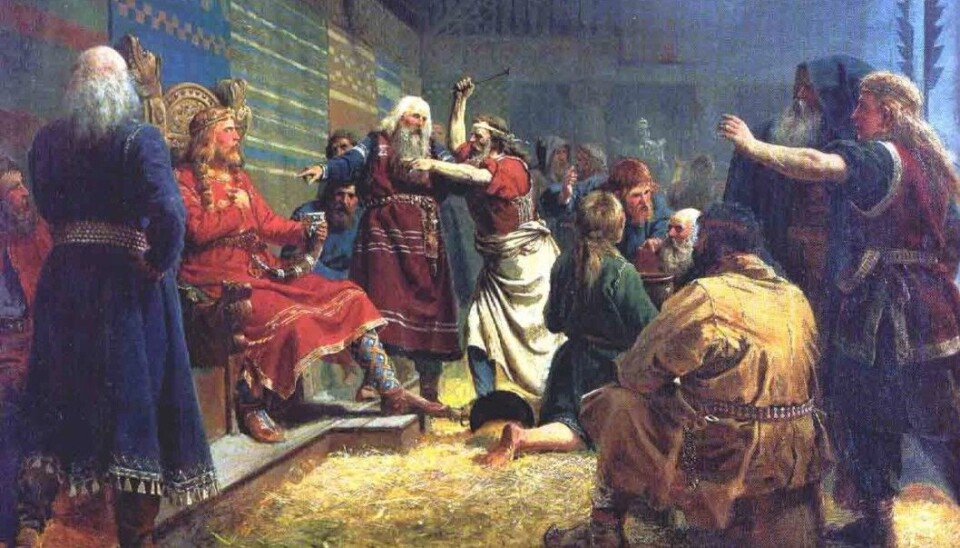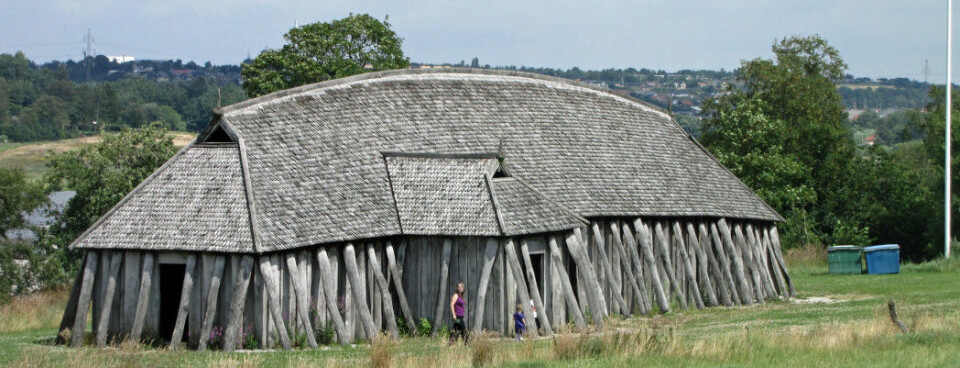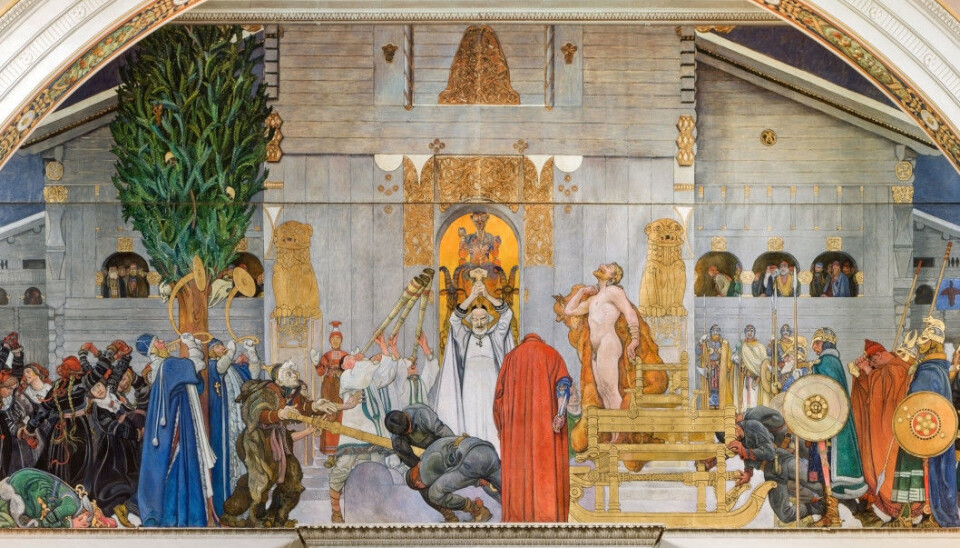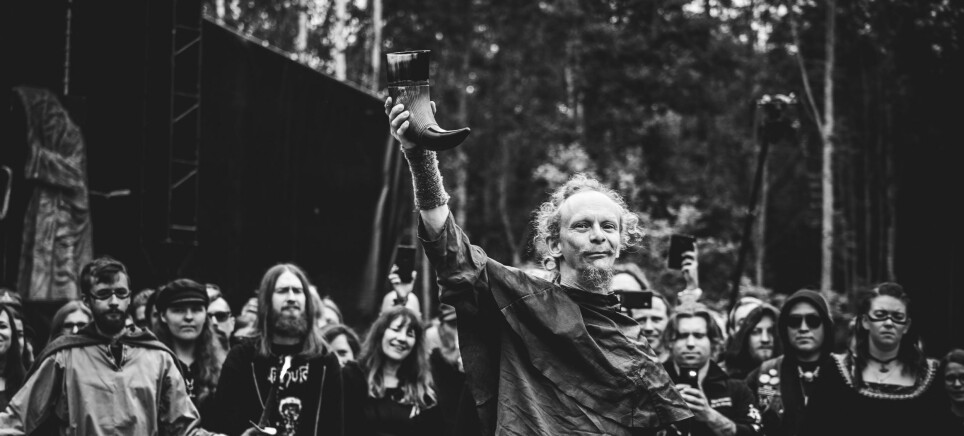
Here's how Vikings celebrated Christmas
They drank, and they ate horse meat.
The Vikings began their Christmas celebration at home, says Herleik Baklid, a cultural historian at the University of South-Eastern Norway. Then they would begin socializing.
People came walking and riding on horses and in sledges with sheepskin rugs over their shoulders. The chieftain in the area had invited everyone to the midtvinterblot, a midwinter sacrificial feast. The guests brought barrels of beer, mead, food, and perhaps some animals to be slaughtered.
The fireplaces were lit and decorated in the long house, in the main yard. This was Christmas celebrations, Viking style.
Hökunótt
It is difficult to say exactly when Christmas was celebrated during the Viking era. But it was probably around winter solstice.
Christmas is as a tradition is far older than the Viking Age. In many old cultures it was common to have parties to celebrate the cycle of the seasons.
“The timing of the Christmas celebration probably had to do with very old ideas that you had to do something for the gods so that they would bring the sun back,” says Elise Kleivane, who does research on Old Norse philology at the University of Oslo.
The Vikings called their sacrificial celebrations “blot” and held them in honour of the Norse gods. These rituals were not only held during Christmas, but also during midsummer and in the transition from autumn to winter.
In King Håkon the Good's saga, author Snorre Sturlason wrote that Christmas was earlier held in the middle of winter on Hökunótt, which was January 13. “Christmas was celebrated for three nights," he wrote.
This worked well with the Vikings' calendar, says Baklid. The Vikings divided the year into two seasons: winter began October 14, and summer began April 14.
Not a four-hour party
Even in the middle of the harshest winter, people travelled to attend Christmas festivities. Perhaps it was a welcome event at a time of year when there was not much else to do.
“I think that these Christmas celebrations were celebrated at the large estates,” says Jon Vidar Sigurdsson, a professor of history at the University of Oslo.
“It’s easy to imagine that the chieftains invited their friends and wives to mark the midwinter. It would have been a pretty big party,” he says.
But who paid for the festivities? Was it the chieftain alone? Or did the farmers bring food and drink?
Sigurdsson believes it was the latter. Feeding 300 to 500 people would be quite expensive.
People gathered in the longhouse. The building was perhaps tens of metres long and had a high ceiling. There would be big fires in the fireplaces so the guests wouldn’t freeze.
"This was not a four-hour party and then return home," Sigurdsson says.
The travel back and forth took time, and these were big parties that lasted three to four days.
- RELATED: Read more about what the Vikings actually ate.
"Paint the stables red"
In Håkon the Good's saga, Snorre writes about how a traditional blot was conducted.
By pagan custom, all peasants were supposed to go to the place of worship, which was the longhouse or square. They should bring enough food for the entire blot, and beer for the feast.
He also writes that sheep and horses were killed, and the blood stored in bowls.

Then participants were supposed to take brushes, and paint the altars and the inner and outer walls of the temple red, and then sprinkle blood on the men.
The meat was cooked. There were fireplaces in the middle of the floor of the temple, and above them hung big pots. The chieftain blessed the cups and the food.
Then it was time for a toast, according to Snorre. First they blessed Odin's cup and drink for the king's victory and power. Then they drank to the gods Njord and Frøy for a good year and peace. It was also common to drink to the god Brage, to remember dead friends, Snorre wrote.
Likely similar to other parties
Jon Vidar Sigurdsson says that there’s no way to know if Snorre's descriptions of the traditional blots are correct.
“It’s obvious that they had rituals. Maybe they also threw blood on the walls and put some blood on the face of those who performed the rituals,” he says.
Probably the Christmas feast didn’t differ that much from other festivities such as the midsummer blot, Sigurdsson says.
According to Elise Kleivane, Snorre was a learned Christian man who wrote the saga of Håkon the Good more than 200 years after the events took place.
“It might well be that they toasted to the gods in a particular order. But Snorre probably also tried to make the Norse mythology fit with the gods of ancient Greece and Rome, that preceded Christianity,” she says.
She says it's important to remember that traditions may have been different from place to place. It might be that people toasted to a different god in the north than in southern Norway.
RELATED Read more about the Viking way of life:
- Vikings had a completely different relationship to animals than we have today
- Viking children practiced with swords and quickly grew up to become adults
Tired of warm women's rooms
That the vikings did a lot of toasts is fairly certain.
Jon Vidar Sigurdsson laughs when asked if beer was an important part of the celebration.
“Oh yes, that was an inseparable part of the celebration. This was a society where people drank a lot of beer,” he says.
The oldest source that mentions Christmas is a skaldic poem about Harald Fairhair from the late 800s. It describes how the king was tired of Christmas time with indoor life, stews and warm women's rooms. Here you get the impression that Christmas might not have been as different as we know it today. But Harald wanted to "drink Christmas" out on the ocean. There he would play Frøy's game, which meant battle.
Beer drinking remained an important tradition when they started to celebrate the Christian Christmas. According to Snorre, Håkon the Good made it the law that "Christmas should be held at the same time as with Christian people, and every man should have a specified amount of malt beer," or risk fines. The Christmas celebration was to last as long as the beer lasted.
In the Gulating Act of 1100, it says that a farmer could lose his farm and land if he failed to brew beer three years in a row.
Mealtime between humans and gods
“A blot was a party where animals were slaughtered and eaten, and people drank a lot of beer. People might not get extremely drunk, but they were at least a little intoxicated the whole time,” says Sigurdsson.
The feast was a gesture to the gods.
“They sacrificed and gave gifts to the gods on behalf of the community. Then they drank and ate the meat that was given to the gods. In a way, it was a meal shared between humans and gods,” he says.
There was also entertainment.
“There were likely performances, with poetry and sagas. The chieftains themselves were quite well schooled in the art of storytelling,” he says.
There were stories of daring voyages at sea, of the king's unparalleled generosity, and of ravens rejoicing over the enemy's bloody limbs. Maybe there was singing and music. It’s not hard to imagine that the party got pretty lively as the hours slipped into the winter’s night.
“If you walked into the hall, you would immediately see who was the most distinguished guy at the feast. That would be the chieftain,” Sigurdsson says.
He sat in the high seat, perhaps with his wife next to him. Then his most important men sat close by.
“People who were the least respected sat farthest from the chieftain. The social hierarchy was reflected in where people sat,” he says.
- RELATED: Did you know that Norway recently excavated a real life Viking ship? Mostly dilapidated, but layers of soil and turf tell the tale of a grand Viking ship burial.
Religion and politics
The Vikings were probably religious. But there’s no evidence of that in written sources from the period, Elise Kleivane says.
“They showed their religiosity in their practices rather than in doctrines and prayers. In any case, they didn’t feel the need to record this in writing, as was done in Christian times,” she says.
There was no full-time priests, but the chieftains often took on the role of leading rituals.
“People were probably religious in that they had anniversaries where they made sacrifices or celebrated in honour of and to influence gods, depending on which god fit best. I would guess that they were more religious when life was difficult, as is true today,” Kleivane says.
Odin was likely to have played a part in the Christmas celebrations. This god had many names and was sometimes called Jólnir, which meant Christmas-Odin. But records also show that the plural form, jólnar, was also used. It was likely not just Odin who was honoured.
“People drank for a good year and peace,” says Herleik Baklid.
“We must remember that the crops and peace were key factors at this time. People were dependant on good crops, because it was hard to find food if the crops failed. There was also conflict and unrest in the country,” he says.
But the celebrations were just as much about building loyalty among people, Kleivane says. The leaders depended on support and cohesion.
“The celebrations were a manifestation of the chief's power and prosperity. They invited people, gave them gifts and food, and the feasts lasted for days.
A chieftain had to be generous.
Had to eat horse meat
Sigurdsson says it is likely that a lot of horses were slaughtered and eaten.
“Horse meat is linked to Odin. People also ate other kinds of meat, but horse meat is most strongly connected to the pre-Christian cult,” he says.
The Gulating Act prohibited the eating of horses, probably because it was linked to pagan practices.
“It probably also had to do with the fact that the horse was very important for work and transport,” says Kleivane.
In Håkon the Good's story, Snorre writes about when king Håkon attended the autumn blot in Lade, in the middle of Norway. But the king refused to take part in the local traditions. He was raised in England and he was a Christian.
At the party, he drank beer from the horn, but first he crossed himself. Some of the farmers were sceptical, wondering, "Why does the king do this?" Earl Sigurd defended Håkon, and lied: "he made the mark of the hammer”.
The next day, the farmers wanted Håkon to eat horse meat, but he refused. They asked him to drink the soup, or at least eat the fat. But he wouldn't do this either. At that point, the farmers were close to "going against him".
Earl Sigurd asked the king to open his mouth over the handle of the pot to appease the guests. The handle had a coating of fat from the steam of the horse meat stew. Then Håkon went forward, put a linen cloth over the handle and opened his mouth over the pot. No one was particularly pleased, wrote Snorre.
Next year Christmas celebration were held for the king in the same area. The large landowners made a plan to force the king to make a sacrifice. Håkon had to drink everything in the cups that were served to him, without making a cross, and he had to eat horse liver. The king was "very unhappy", Snorre wrote. He was so unhappy that he made plans to return with a large army. But in the end there was a reconciliation.
Keeping the Fimbul winter away?
There are several theories as to the reason behind the Viking Christmas.
Making sacrifices to the gods in the hope of a new good year seems to have been part of the religious aspect.
The skaldic poem Ynglingatal tells of several years of crop failures in Uppsala, Sweden. King Domalde sacrificed both animals and people. Finally, he allowed himself to be sacrificed in the winter blot.
"Domald dies by bloody arms, raised not by foes in war's alarms —Raised by his Swedish liegemen's hand, To bring good seasons to the land," the skaldic ode said. Whether the story is true or invented is unknown.
“The midwinter feast might also had elements of ancestral worship or sun festival,” says Baklid.

Perhaps the Vikings and their ancestors feared that the sun would be devoured by the powers of chaos. Then the long Fimbul winter would come before Ragnarok, a series of events including a huge battle that ended with the destruction of the gods and the end of the world.
- RELATED: You definitely want to read more about the Fimbul winter in our article The long, harsh Fimbul winter is not a myth
This may have given them reason to hold a blot to strengthen Odin in the fight, suggested Ivar Lindtvedt Hille in his master's thesis on Nordic Viking and medieval culture from the University of Oslo in 2007.
Jon Vidar Sigurdsson says that the Christmas feast was also simply a celebration, and we actually know little about what they were actually celebrating. He says it’s important to emphasize that Christmas celebration was very local. The celebration was not the same all over Scandinavia.
Elise Kleivane points out that we have almost no written material from the Viking Age, and that the later sources are uncertain.
“Nevertheless, we have to look at what we have and try to see what we can make of it,” she says.
Translated by: Nancy Bazilchuk.
Reference:
Snorre Sturlasøn: “Håkon den Godes saga”, Kings Sagas, translated into Norwegian by Gustav Storm, 1900. Chapters 13 - 19. Heimskringla.no.

































